Prime Minister Shigeru Ishiba resigned on September 7, citing the conclusion of United States US–Japan tariff talks as a “natural juncture.” His departure comes at a moment of historic weakness for the Liberal Democratic Party (LDP), which in July lost its majority in both chambers of the Diet for the first time in the postwar era. The party will hold its leadership election on October 4.
While there are five candidates in the running—Shinjiro Koizumi, Yoshimasa Hayashi, Toshimitsu Motegi, Takayuki Kobayashi, and Sanae Takaichi—polls suggest the race is narrowing to a contest between Takaichi and Koizumi. Takaichi positions herself as a nationalist conservative who favors an expansionary fiscal and monetary stance, while Koizumi presents himself as a reformist emphasizing generational change and continuity with Ishiba’s fiscal discipline.
The 2025 leadership race is more about pragmatism than ideology. As a minority ruling party, the LDP’s next leader will be judged not on bold policy agendas but on their ability to unify the party and build workable ties with the opposition. Their success will determine whether Japan regains political stability or faces deeper uncertainty.
For businesses, the outlook is one of limited stability. Whoever wins will face restricted room for unilateral policymaking, resulting in broad policy alignment. Keeping an eye on the election results and the ensuing coalition developments will be crucial to understanding Japan’s political and economic future.
Resignation of Prime Minister Shigeru Ishiba
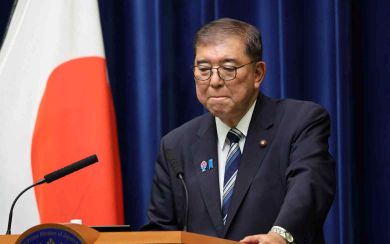
On September 7, Prime Minister Shigeru Ishiba announced his resignation as president of the Liberal Democratic Party (LDP) during an emergency press conference at the Prime Minister’s Office. The decision came after growing calls within the party to expedite the leadership election—effectively indicating that Ishiba had lost the confidence of his colleagues. To prevent further internal divisions, Ishiba decided to step aside.
He justified the timing by referencing the conclusion of US–Japan tariff negotiations, which was marked by President Trump’s executive order reducing tariffs on Japanese automobiles. Ishiba described this as “a natural juncture” to step down.
Although his cabinet’s approval ratings had risen after the July Upper House election, Ishiba lacked a secure base within the LDP and could not withstand pressure for early resignation. In his remarks, he reflected on the party’s disconnect with the public, noting “[how] we must always consider the gap between what the people are thinking and what the party is doing.”
Election Schedule and Voting System
The LDP leadership race officially began on September 22, with voting and results scheduled for October 4. The party has opted for the full-spec system, the most comprehensive format of its presidential elections.
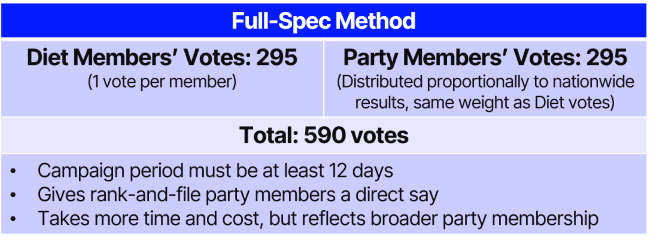
Under this system, the contest is decided by two groups of voters:
- Diet members’ votes (295 in total), with each LDP lawmaker in both chambers holding one vote.
- Rank-and-file party members’ votes (also 295 in total), allocated proportionally based on nationwide membership ballots.
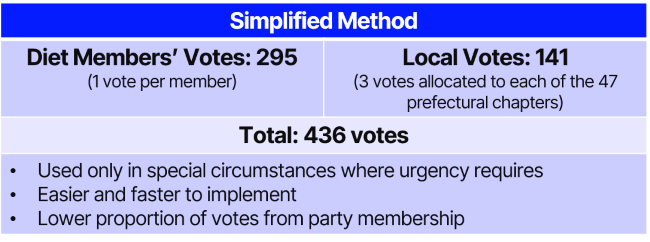
This results in an initial pool of 590 votes. If any candidate wins an outright majority in the first round, they are immediately elected president. However, if no candidate surpasses that threshold—as is widely expected this year—the top two candidates go on to a runoff.
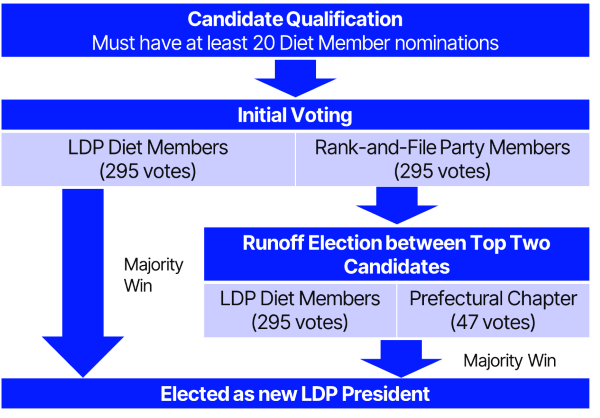 In the second round, the balance shifts: party membership ballots are no longer counted proportionally. Still, they are converted into 47 bloc votes, with each prefectural chapter awarding one vote to the finalist who received the most support locally. Combined with the 295 Diet votes, this yields a total of 342 runoff votes, heavily tilting influence toward lawmakers.
In the second round, the balance shifts: party membership ballots are no longer counted proportionally. Still, they are converted into 47 bloc votes, with each prefectural chapter awarding one vote to the finalist who received the most support locally. Combined with the 295 Diet votes, this yields a total of 342 runoff votes, heavily tilting influence toward lawmakers.
It is worth noting that the voice of rank-and-file party members does not represent the voice of LDP supporters, let alone the general public. Although the exact demographics of LDP members are not disclosed, they tend to be older and more closely connected to industry groups or local political networks. Their preferences can vary considerably from wider public sentiment. Consequently, candidates who are popular nationwide may find it difficult to translate that support into votes within the party—a pattern seen in past contests and likely to influence the 2025 race.
Key Themes of the Race: Party Unity and Opposition Cooperation
The 2025 LDP presidential election takes place under extraordinary circumstances. Following its historic defeat in July’s Upper House poll, the LDP lost its majority in both chambers for the first time since the postwar period. As a minority governing party, its next leader will be judged more on the ability to maintain stability than on ideology.
Party Unity under Strain
The LDP’s internal cohesion is at its weakest in decades. A series of funding scandals and controversy over ties to the Unification Church have eroded trust, while the dissolution of most factions has removed traditional mechanisms for coordination. Only the Aso faction remains intact, making personal networks more critical than ever.
At the same time, younger voters are turning away from the party, heightening calls for generational change. Ishiba’s resignation showed how even a prime minister with decent public approval can falter if they cannot unify party support or establish a clear policy identity. For the candidates, the lesson is that coordination and consensus-building now matter more than ideological purity.
Necessity of Opposition Cooperation
In today’s minority government environment, winning the LDP presidency does not automatically ensure the premiership. The new leader must still prevail in a Diet vote, where a united opposition could, in theory, block the LDP and install its own candidate.
Even if confirmed as prime minister, governing will require coalition-building beyond the LDP and its traditional partner, Komeito. In the House of Representatives, support from at least one major opposition party—the Constitutional Democratic Party (CDP), Japan Innovation Party (Ishin), or the Democratic Party for the People (DPP)—is essential to pass budgets and key legislation. The immediate test will be negotiating the FY2025 supplementary budget and the FY2026 budget and tax reform package, which will demand compromises with the opposition.
Some within the party are also calling for broader coalition frameworks to stabilize governance, raising the possibility that candidates will be pressed during the campaign to clarify whether they would pursue partnerships with parties such as Ishin or the DPP.
Implications for Candidate Strategy
While the candidates’ stance on policy remains relevant, the election is less about grand ideological battles and more about the ability to navigate intra-party and inter-party dynamics. Crucial questions are:
- Can the next leader unify a fragmented party?
- Can they forge workable ties with opposition parties without abandoning the LDP’s core policy identity?
Five Contenders
Five LDP Diet members have formally entered the 2025 presidential race: Shinjiro Koizumi, Yoshimasa Hayashi, Toshimitsu Motegi, Takayuki Kobayashi, and Sanae Takaichi. On the political spectrum, the candidates range from the reformist-progressive side to the conservative-nationalist end as below:
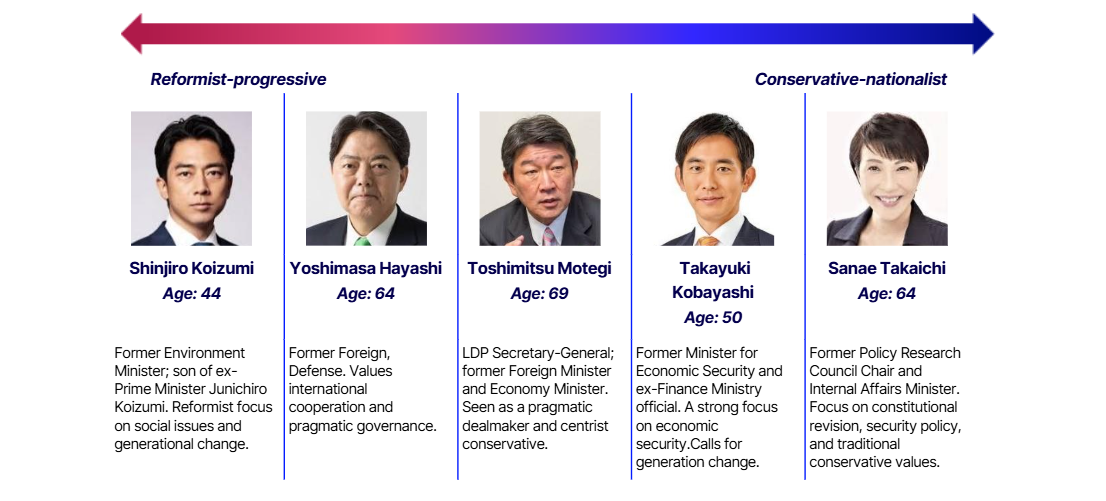
All five ran in the 2024 race, but the political environment is markedly different this time. With the LDP now a minority party, candidates have softened their signature agendas. Unlike last year’s contest, which highlighted ideological divides such as fiscal conservatism versus active spending or progressivism versus traditional values, this year’s tone is more restrained. Candidates are careful to avoid deepening intra-party rifts or alienating potential opposition partners, instead emphasizing “pragmatic leadership under constraints”—the ability to unify the party and navigate multiparty negotiations rather than advance bold personal visions.
Candidate Policy Platforms
The table below outlines the major themes from each candidate’s policy announcement to date.
| Shinjiro Koizumi | Yoshimasa Hayashi | Toshimitsu Motegi | Takayuki Kobayashi | Sanae Takaichi |
|---|---|---|---|---|---|
Economy | Mobilizes all policies to achieve around 1% real wage growth per year. Targets 135 trillion yen in domestic investment and a 1 million yen rise in average wages by FY2030. Proposes revising the income tax system to adjust basic deductionsin line with price and wage increases. Dismisses cash handouts as difficult to implement. Supports prompt abolition of the provisional gasoline tax rate. | Aims for sustained 1% real wage growth, with support for SMEs and micro-businesses. Proposes a “Japan-style Universal Credit” to calibrate household support based on combined tax and social insurance burdens. Reconsiders the 20,000-yen cash handout plan. Opposes consumption tax cuts. | Proposes multi-trillion-yen “Special Local Allocation Grant for Livelihood Support” to counter rising prices. Targets raising average annual income above 5 million yen within three years. Cancels 20,000-yen cash handout plan. Cautious on consumption tax cuts. Supports abolishing provisional gasoline tax rate. | Supports flat-rate income tax cut for young and working generations. Aims to make Japan a technology powerhousewith investments in AI, quantum, and space. Opposes consumption tax cut as anti-inflation measure, but keeps it as an option if economic outlook worsens. Supports abolishing provisional gasoline tax rate. | Advocates “responsible proactive fiscal policy.” Proposes a system of tax credits with cash benefits to support low-income households. Rejects cash handouts, calling them a policy that lacked public support. Supports abolishing provisional tax rates on gasoline and diesel. |
Social Security | Supports realizing an all-generation social security system that ensures security for every generation. | Supports building a sustainable social security system and addressing the 2040 problem as the second baby boom generation turns 65+. | Supports reducing social insurance premiums. | Supports easing the social insurance premium burden on the working generation. | Promotes lifelong dental checkups (“universal dental screening”) and comprehensive preventive healthcare to optimize medical costs and extend healthy life expectancy. |
Foreign Policy and National Security | Supports steadily strengthening defense capabilities and expanding cooperation with like-minded countries—including South Korea, India, and Australia—while keeping the Japan–US alliance as the cornerstone. Backs increasing defense spending to 2% of GDP. | Supports strengthening deterrence and response capabilities of the Japan–US alliance. On defense spending, favors close coordination with the US to set appropriate levels and quality. Seeks to lead international discussions on global issues such as climate change. | Prioritizes reducing US tariffs on automobiles and other products to 15%, while open to further cuts if possible. | Seeks to deepen the Japan–US alliance while enhancing autonomy. Supports revising the National Security Strategy and increasing defense spending. Backs tighter regulations on foreign land acquisitions and criminal penalties for disinformation by foreign actors. | Supports building up defense spending. Aims to establish a national defense posture capable of addressing new domains such as space and cyber. Proposes creating a “National Intelligence Bureau” to serve as command center for intelligence-related ministries. Seeks to strengthen economic security by creating a “Foreign Investment Review Committee” to strictly screen overseas investment into Japan. |
Constitutional Reform | Supports initiating amendments in the Diet and holding a national referendum, based onLDP’s four constitutional amendment items including explicit mention of the Self-Defense Forces and addition of emergency clauses. | Aims to build public understanding of the LDP’s four constitutional amendment items, including explicit mention of the Self-Defense Forces and addition of emergency clauses, and pursue initiation of amendments in the Diet. | Not addressed this time but showed will to realize constitutional amendments within three years in 2024. (LDP) | Supports initiating constitutional amendments during term, including explicit mention of the Self-Defense Forces and addition of emergency clauses. | Asserts that, as an LDP leadership contender, the top priority is to amend the Constitution to meet the demands of the times. |
Separate Surnames | Takes a proactive stance and maintains support, but stresses politics must set clear policy priorities. Holds that issues touching on views of family and life require continued efforts to build public understanding. | Cautious, introducing a poll showing that majority favors expansion of maiden name use instead. | Cautious, favors further study on whether expanding the use of maiden names can effectively address inconveniences. | Not addressed this time but showed caution in the past, noting families could end up with siblings having different surname and arguing that burdens and risks mainly borne by women through name changes can be resolved by expanding the use of maiden names as common names. (Asahi Shimbun) | Not addressed this time. But generally opposes separate surnames and instead supports expanding the use of maiden names. |
Energy
| Supports the new Basic Energy Plan, prioritizing stable energy supply with safety as a prerequisite, while pursuing greater economic efficiency and environmental compatibility. | Not addressed this time, but has expressed support restarting nuclear plants that meet Nuclear Regulation Authority standards, with the understanding of local communities. (Nikkei) | Not addressed this time, but has emphasized securing non-CO2-emitting power sources, including nuclear power, as critically important.(Nikkei) | Prioritizes economic security. Supports promotion of nuclear power. Opposes promotion of solar power generation. | Emphasizes strengthening energy resource security. Supports operating nuclear power plants with safety as a prerequisite and implementing simple, high-safety next-generation innovative reactors. Strongly opposes covering Japan with foreign-made solar panels. |
Party Reform | Supports thorough transparency in political funding to prevent a recurrence of “money and politics” scandals. | Calls for “rebuilding from zero” by revising the party platform to clarify the LDP’s position. Supports reassessing the merits of the multi-member district system. | Pledges ongoing zero-based review of party discipline and financial structure. Supports promotion of mid-level and younger members. Cautious about abolishing corporate and organizational donations. | Calls for generational change and supports improving speed and transparency in decision-making. | Supports thorough transparency in political funding. Seeks to build mechanisms to reflect voices of party members nationwide in policy. |
Opposition Cooperation | Calls for broad policy consultations and efforts to build consensus. Carefully assesses alignment of policies and principles while considering expansion of the coalition framework. | Emphasizes policy-based cooperation. Holds that choosing coalition partners should not be a topic for the current leadership election. | Seeks a new coalition framework, viewing Ishin and DPP as potential partners. | Stresses importance of policy-based cooperation. Sees coalition emerging only after policy alignment. | Holds the LDP–Komeito coalition as the basic framework but is open to forming coalitions with opposition parties that share core policies. |
Sources |
Recent Polls and Outlook
Who does the public want: Takaichi or Koizumi?
Polls indicate that the 2025 LDP presidential race is shaping up as a contest between Sanae Takaichi and Shinjiro Koizumi. A Kyodo News survey conducted on September 11–12 asked who would be most suitable as the next LDP president and placed Takaichi first with 28.0 percent, followed by Koizumi at 22.5 percent and Yoshimasa Hayashi at 11.4 percent. A Yomiuri Shimbun poll on September 13–14, using the same question, showed a similar overall ranking but revealed an important nuance: while Takaichi led among the general public with 23 percent, Koizumi was the clear favorite among self-identified LDP supporters at 32 percent, well ahead of Takaichi’s 17 percent. A separate survey by Senkyo.com and JX Communications, conducted the same weekend, also confirmed the two-way race but showed methodological differences: in its telephone poll of older respondents, Koizumi led among LDP supporters (33.5 percent) ahead of Takaichi (23.0 percent), whereas in the internet poll of younger respondents, Takaichi held the advantage. Finally, a Nikkei Shimbun survey in August, which asked who would be most suitable as the next prime minister rather than LDP president, found the two essentially tied—Takaichi at 23 percent and Koizumi at 22 percent—underscoring how close the contest remains.
Who has a say in this election?
While public opinion polls act as a popularity guide, it is ultimately LDP Diet members and party members who influence this election.
Diet Members: Declining Factional Control, Rising Unpredictability
Traditionally, LDP presidential elections have been fought along factional lines, with each faction rallying its members behind a designated candidate. Factions also provided the manpower and financial resources to mobilize party members nationwide. That system has largely collapsed. In the wake of political funding scandals, five of the LDP’s six major factions disbanded, leaving only the Aso faction intact. Without these traditional power blocs to coordinate support, Diet members are freer to vote based on personal networks, regional ties, or short-term political calculations. This erosion of factional discipline not only weakens the predictability of parliamentary votes but also increases the importance of behind-the-scenes deal-making during the campaign.
Party Members: A Black Box Electorate
The second half of the vote comes from LDP party members—a group often described as a “black box” because so little is known about them. Crucially, they do not necessarily represent the broader base of LDP supporters or public opinion. According to party insiders, the rank-and-file tends to skew older, with many being men over 60. Within this group, two broad categories exist:
- Organized members (“shokuiki”), recruited through industry associations such as medical or construction groups. These votes, which account for roughly 30 percent of the total, often move as a bloc in line with organizational preferences, though their share has been declining.
- General members, recruited individually by Diet members and their offices. This segment is less predictable, reflecting local loyalties and the personal reach of lawmakers.
Together, these dynamics mean that the actual outcome will hinge on the interplay of Diet member calculations, Aso faction maneuvering, and the opaque preferences of party members—a combination that makes this election particularly difficult to forecast.
Policy Implications for Businesses
Fiscal Discipline vs. Expansion: Market Scenarios
Markets are closely monitoring the LDP presidential race, with expectations diverging between the two frontrunners. A Koizumi victory would signify continuity with Ishiba’s approach to fiscal discipline. Strategists believe this would reassure bond investors, driving long-term yields down towards 3.0 per cent, while also supporting a stronger yen, potentially appreciating to around JPY 145 per US dollar. However, equities could experience a modest correction, as Koizumi is not seen as a driver of aggressive stimulus and is likely to distance himself from the opposition’s calls for tax cuts and fiscal expansion.
In contrast, a Takaichi victory is expected to lead to a more expansionary stance, both fiscally and monetarily. Investors believe that her promises to promote growth through substantial spending, along with her backing for continued monetary easing, would drive a stock market rally. Some forecasts indicate the Nikkei 225 could rise towards JPY 48,000 by year-end, with defence, nuclear, and advanced technology sectors benefiting. However, this optimism carries risks: bond markets are cautious of further debt issuance, and currency strategists foresee more yen weakness, potentially by two yen against the dollar.
For Hayashi, Motegi, and Kobayashi, market expectations remain modest, as all three are viewed as continuity candidates with limited impact on equities, bonds, and foreign exchange. Nevertheless, the sharp reversal following Ishiba’s surprise victory in 2024 serves as a reminder that markets can shift suddenly, keeping investors vigilant to volatility until the October 4 vote.
Source: Nikkei
Policy Convergence: A Stable but Constrained Outlook
At first glance, the race between Koizumi and Takaichi suggests stark ideological divergence: Koizumi as a reformist, socially progressive figure versus Takaichi as a conservative emphasizing national security and traditional values. Yet in practice, the scope for differentiation is narrow. With the LDP now a minority party, the next leader will be forced to prioritize party unity and opposition cooperation over personal policy agendas. As a result, broad policy convergence is expected. For businesses, this means a degree of political stability despite leadership change—a contrast to the uncertainty that leadership contests might otherwise generate.
The Role of the Opposition: From Obstacle to Partner
The next LDP leader cannot govern alone. Passage of budgets, tax reforms, and industrial policies will require support from at least one major opposition party (CDP, Ishin, or DPP). This elevates opposition parties from opponents to critical gatekeepers. Companies should track not only the LDP’s platform but also opposition priorities, since the compromises struck across party lines will increasingly determine final policy outcomes. In some cases, engaging with opposition parties may complement traditional LDP outreach and help shape the eventual compromise.
Challenges and Opportunities
Fragmentation in the Diet raises new challenges for corporate strategy, but also opens new channels for engagement.
- Broader engagement: Businesses can no longer rely solely on the LDP. Building relationships with opposition parties, local governments, and other stakeholders—as well as aligning with international frameworks where relevant—will be increasingly important to anticipate and shape policy outcomes.
- Planning for delays: Greater legislative complexity raises the likelihood of slower decision-making and diluted reforms. Companies should prepare for longer policy cycles and strengthen scenario planning to manage uncertainty effectively.
Materials presented by Edelman Global Advisory Japan. For additional information, reach out to Yuichi.Kori@EdelmanEGA.com



